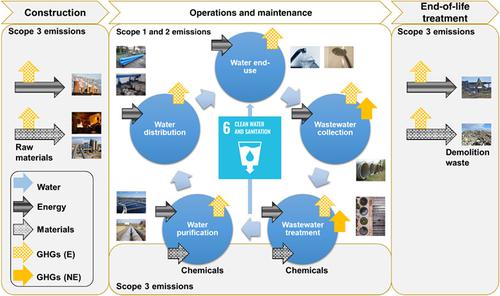当前位置:
X-MOL 学术
›
WIREs Water
›
论文详情
Our official English website, www.x-mol.net, welcomes your feedback! (Note: you will need to create a separate account there.)
Greenhouse gas emissions associated with urban water infrastructure: What we have learnt from China's practice
WIREs Water ( IF 8.2 ) Pub Date : 2021-04-21 , DOI: 10.1002/wat2.1529 Qian Zhang 1 , Kate Smith 2 , Xu Zhao 3 , Xinkai Jin 4 , Shuya Wang 5 , Junjie Shen 6 , Zhiyong Jason Ren 7
WIREs Water ( IF 8.2 ) Pub Date : 2021-04-21 , DOI: 10.1002/wat2.1529 Qian Zhang 1 , Kate Smith 2 , Xu Zhao 3 , Xinkai Jin 4 , Shuya Wang 5 , Junjie Shen 6 , Zhiyong Jason Ren 7
Affiliation

|
Municipal water and wastewater services have complicated sources of greenhouse gas (GHG) emissions, and quantifying their roles is critical for tackling global environmental challenges. In this study we provide a systematic review of the state-of-the-art on GHG emission characterizations of China's urban water infrastructure with the aim of shedding light on global implications for sustainable development. We started by synthesizing a framework on GHG emissions associated with water and wastewater infrastructure. Then we analyzed the different sources of GHG emissions in drinking water and wastewater treatment systems. In drinking water services, electricity consumption is the largest source of GHG emissions. A particular concern in China is the common use of secondary pumping for high-rise buildings. Optimized pressure management with an efficient pumping system should be prioritized. In wastewater services, non-CO2 emissions such as methane (CH4) and nitrous oxide (N2O) emissions are substantial, but vary greatly depending on regional and technological differences. Further research directions may include GHG inventory development for urban water systems at the plant level, quantifications of GHG emissions from sewer systems, emission reduction measures via water reclamation, renewable energy recovery, energy efficiency improvement, cost–benefit analyses, and characterizations of Scope 3 emissions.
更新日期:2021-06-04



























 京公网安备 11010802027423号
京公网安备 11010802027423号